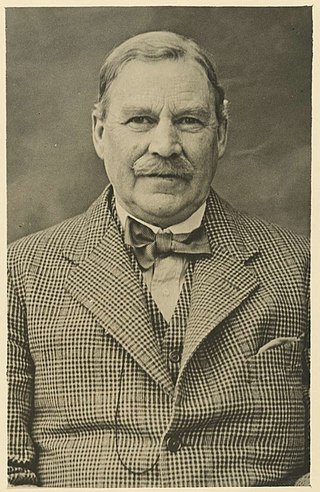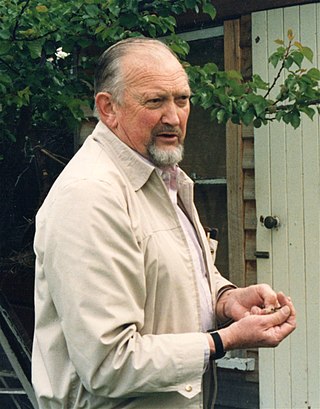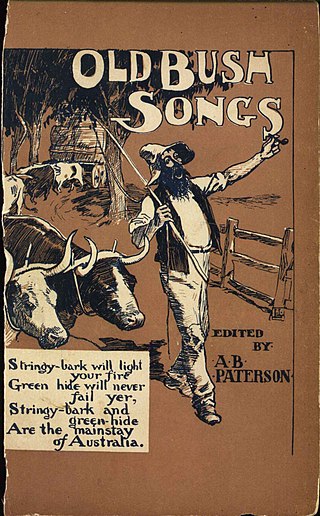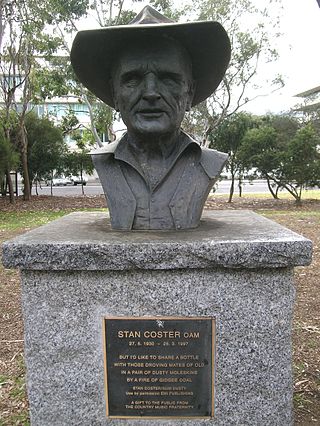
"Waltzing Matilda" is a song developed in the Australian style of poetry and folk music called a bush ballad. It has been described as the country's "unofficial national anthem".

The music of Australia has an extensive history made of music societies. Indigenous Australian music forms a significant part of the unique heritage of a 40,000- to 60,000-year history which produced the iconic didgeridoo. Contemporary fusions of indigenous and Western styles are exemplified in the works of Yothu Yindi, No Fixed Address, Geoffrey Gurrumul Yunupingu and Christine Anu, and mark distinctly Australian contributions to world music.

Andrew Barton "Banjo" Paterson, was an Australian bush poet, journalist and author, widely considered one of the greatest writers of Australia's colonial period.

Slim Dusty, AO MBE was an Australian country music singer-songwriter, guitarist and producer. He was an Australian cultural icon, referred to universally as Australia's King of Country Music and one of the country's most awarded stars, with a career spanning nearly seven decades and producing numerous recordings. He was known to record songs in the legacy of Australia genre, particularly of bush life, including works by renowned Australian bush poets Henry Lawson and Banjo Paterson, who represented the lifestyle. The music genre was coined the "bush ballad", a style first made popular by Buddy Williams. Dusty was also known for his many trucking songs.
"Clancy of the Overflow" is a famous Australian poem written by Banjo Paterson and first published in The Bulletin, an Australian news magazine, on 21 December 1889. The poem is typical of Paterson, offering a romantic view of rural life, and is one of his best-known works.

William Henry Ogilvie was a Scottish-Australian narrative poet and horseman, jackaroo, and drover, and described as a quiet-spoken handsome Scot of medium height, with a fair moustache and red complexion. He was also known as Will Ogilvie, by the pen names including 'Glenrowan' and the lesser 'Swingle-Bar', and by his initials, WHO.

Australian country music is a part of the music of Australia. There is a broad range of styles, from bluegrass, to yodeling to folk to the more popular. The genre has been influenced by Celtic and English folk music, the Australian bush ballad tradition, and popular American country music. Themes include: outback life, the lives of stockmen, truckers and outlaws, songs of romance and of political protest; and songs about the "beauty and the terror" of the Australian bush.

A bush band is a group of musicians that play Australian bush ballads. A similar bush band tradition is also found in New Zealand.

Australian folklore refers to the folklore and urban legends that have evolved in Australia from Aboriginal Australian myths to colonial and contemporary folklore including people, places and events, that have played part in shaping the culture, image and traditions that are seen in contemporary Old Australia.

William Neville Scott OAM was an Australian author, folklorist, songwriter, poet, and collector of bush ballads and Australian folk history. He has published anthologies of Australian bush songs, including the best selling book The Complete Book of Australian Folklore published in 1976. He was awarded the Order of Australia in 1992 for his contributions to folklore, folk music, and Australian literature. He was considered a living treasure, and his anthologies of songs and his donated collections continue his legacy.

The Arts in Australia refers to the visual arts, literature, performing arts and music in the area of, on the subject of, or by the people of the Commonwealth of Australia and its preceding Indigenous and colonial societies. Indigenous Australian art, music and story telling attaches to a 40–60,000-year heritage and continues to affect the broader arts and culture of Australia. During its early western history, Australia was a collection of British colonies, therefore, its literary, visual and theatrical traditions began with strong links to the broader traditions of English and Irish literature, British art and English and Celtic music. However, the works of Australian artists – including Indigenous as well as Anglo-Celtic and multicultural migrant Australians – has, since 1788, introduced the character of a new continent to the global arts scene – exploring such themes as Aboriginality, Australian landscape, migrant and national identity, distance from other Western nations and proximity to Asia, the complexities of urban living and the "beauty and the terror" of life in the Australian bush.
"Brisbane Ladies" is an Australian folksong and is one of many adaptations of the traditional British naval song "Spanish Ladies". The song is also known as "Augathella Station". It is numbered 21114 on the Roud Folk Song Index.
"Jim Jones at Botany Bay" is a traditional Australian folk ballad dating from the early 19th-century. The narrator, Jim Jones, is found guilty of poaching and sentenced to transportation to the penal colony of New South Wales. En route, his ship is attacked by pirates, but the crew holds them off. When the narrator remarks that he would rather have joined the pirates or indeed drowned at sea than gone to Botany Bay, Jones is reminded by his captors that any mischief will be met with the whip. In the final verse, Jones describes the daily drudgery and degradation of life as a convict in Australia, and dreams of joining the bushrangers and taking revenge on his floggers.

John Stanley Raymond Meredith OAM was an Australian pioneer folklorist from Holbrook, New South Wales whose work influenced the Australian folk music revival of the 1950s, in particular as a founding member of the Australia's first revivalist bush band The Bushwhackers. He was awarded the Medal of the Order of Australia in 1986 for service to Australian folklore and music, and became a Member of the Order of Australia in 1992 for service to the Arts, particularly in the collection and preservation of Australian folklore.

Australian folk music is the traditional music from the large variety of immigrant cultures and those of the original Australian inhabitants.

Stan Coster was an Australian country music singer-songwriter. His songs were regularly performed by Slim Dusty and other singers. He is the father of country music singer Tracy Coster.
This article presents a list of the historical events and publications of Australian literature in 1892.
Christian Music in Australia has been played since the first European settlers arrived in the late 18th century, and forms part of the cultural life of religion in Australia and worldwide Christian Music. Australians have contributed to a variety of genres of Christian music including the liturgical music, classical music, hymns, Christian rock, country gospel, and Christmas music, as well as cross-over contemporary music sung by popular artists such as Johnny O'Keefe, Paul Kelly, Nick Cave and Slim Dusty. Notable contemporary Christian music milestones in Australia include Sister Janet Mead's rock version of "The Lord's Prayer", which was the first Australian record to sell over a million copies in the United States of America; Jimmy Little's Royal Telephone, which made him the first Aboriginal to attain a No. 1 hit on the Australian charts; and Guy Sebastian's Receive the Power, which welcomed the Pope to World Youth Day 2008.
The Australian music industry refers to the collection of individuals, organisations, businesses and activities that are involved in the creation, production, distribution and promotion of music in Australia. The music industry encompasses a wide range of genres and styles of music including pop, rock, EDM, hip-hop, classical as well as featuring music from Indigenous artists.
"A Bushman's Song" (1892) is a poem by Australian poet A. B. Paterson.














